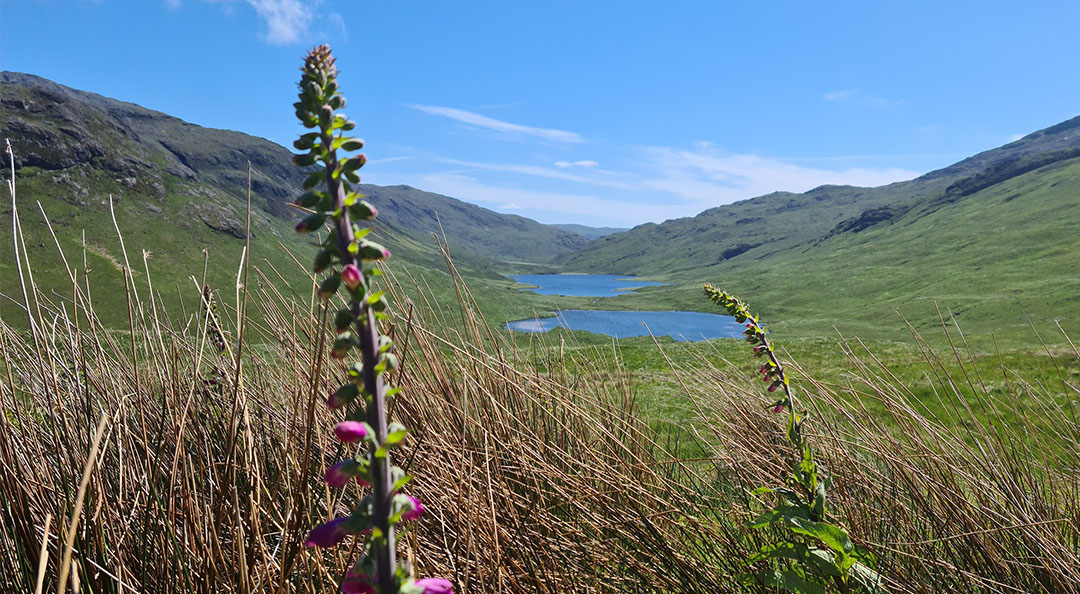
Spectacle Lochs (three lochs) Mull
The Isle of Mull, a jewel in Scotland’s Inner Hebrides, beckons with its dramatic landscapes, vibrant wildlife, and rich history. From the colourful harbour town of Tobermory to the remote, rugged wilderness, Mull offers an authentic Scottish island adventure. If you’re dreaming of sea eagle sightings, ancient castles, or the serene beauty of neighbouring Iona, this ultimate guide will equip you with everything you need for an unforgettable journey.
1. Welcome to the Isle of Mull: Your Gateway to Wild Scottish Beauty
Imagine an island where golden eagles soar above majestic mountains, otters play in crystal-clear lochs, and white sandy beaches stretch for miles. This is the Isle of Mull, Scotland’s fourth-largest island, celebrated for its incredible biodiversity, geological wonders, and welcoming communities. It’s a place where every turn in the road reveals a breathtaking vista, and where ancient history is etched into the very landscape. More than just a destination, Mull is an experience – a chance to reconnect with nature, explore charming villages, and immerse yourself in the tranquil rhythm of island life. Prepare to be captivated by its raw, untamed beauty.

MV Lochinvar Fishnish to Lochaline
2. Getting There & Getting Around: Your Essential Mull Travel Guide
Reaching the Isle of Mull is part of the adventure, almost exclusively via a Caledonian MacBrayne (CalMac) ferry. Understanding your options for arrival and on-island travel is key to a smooth trip.
Getting to Mull by Ferry:
- The Main Route: Oban to Craignure:
- Departure Point: Oban, a bustling port town on the Scottish mainland, often referred to as the “Gateway to the Isles.”
- Arrival Point: Craignure, Mull’s main ferry terminal, located roughly in the centre of the island’s east coast.
- Operator: CalMac Ferries.
- Journey Time: Approximately 45-50 minutes.
- Booking Essential: It is highly recommended to book your ferry crossing well in advance, especially if travelling with a vehicle, as spaces fill up quickly during peak season (April to October). Foot passengers are also advised to book, particularly for popular sailings. Always check the official CalMac website for current timetables (which are generally released seasonally) and to book.
- Alternative Mainland Routes (for specific itineraries):
- Lochaline to Fishnish (Mull): A shorter crossing (approx. 18 minutes), ideal if you’re travelling from the Fort William area or through Ardnamurchan via the Corran Ferry. This is often a “turn up and go” service, but checking the CalMac website for up-to-date guidance, especially concerning the 2025 summer timetable, is always wise.
- Kilchoan to Tobermory (Mull): This route connects the Ardnamurchan Peninsula directly with Tobermory, Mull’s capital. The crossing takes around 35 minutes and typically operates on a “turn up and go” basis. Check the CalMac website for current timetables.
Getting Around Mull:
Mull is a large island, so understanding its unique road network is crucial for a smooth trip.
- Driving on Mull (Predominant Method):
- Single-Track Roads: Crucial to understand. These narrow roads feature designated passing places. Etiquette involves pulling over safely to let oncoming or faster traffic pass; a quick wave of thanks is customary. Patience is essential.
- Main Roads: The A849, running from Craignure to Tobermory and then down to Fionnphort, is a mix of single and double track. Journeys can take longer than anticipated (e.g., Tobermory to Fionnphort can be a two-hour drive).
- Fuel Stations: These are limited, so plan your stops! You’ll find them in **Tobermory**, **Salen**, **Craignure**, and **Ardfenaig**.
- Bus Services: West Coast Motors operates local bus services connecting key locations like Craignure, Tobermory, and Fionnphort. Services are less frequent than on the mainland, so consult their timetables carefully, especially if connecting with ferries. (As of June 2025, their website shows current routes for Mull, including 95/495 Craignure to Tobermory and 96/496 Craignphort to Fionnphort).
- Taxis: Taxis are available but are limited. It’s advisable to pre-book, particularly if you need a pick-up from a ferry terminal or specific location.
- Cycling: Mull offers fantastic cycling opportunities, but be prepared for hilly terrain and the challenges of single-track roads.
- Walking: Many areas are best explored on foot, from town strolls to challenging mountain hikes.
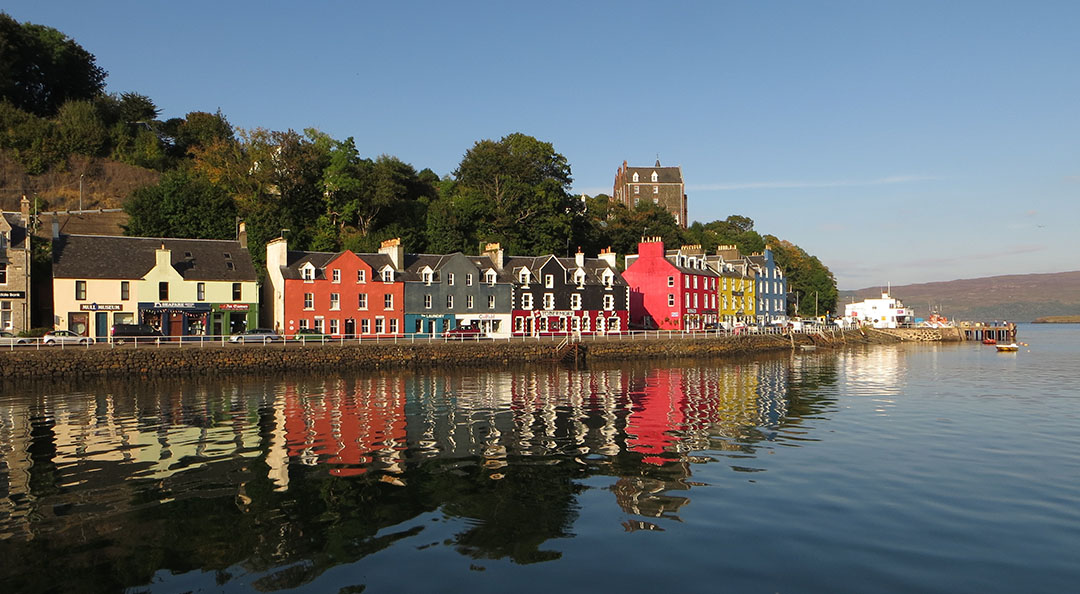
Tobermory’s colorful houses overlooked by the Great Western Hotel
3. Tobermory & Beyond: Exploring Mull’s Charming Towns & Villages
Mull’s settlements offer a mix of vibrant culture, local services, and picturesque views.
- Tobermory:
- The Capital: Mull’s main town and capital, instantly recognisable by its iconic colourful waterfront buildings.
- Attractions: Explore the shops, cafes, and pubs along the harbour. Visit the Tobermory Distillery for a tour and a dram. The Tobermory Arts Centre (An Tobar) hosts exhibitions and events.
- Atmosphere: Tobermory bustles with activity, especially during tourist season, providing a wide range of visitor amenities.
- Craignure:
- Ferry Gateway: As the main ferry port from Oban, Craignure is often your first and last stop on Mull.
- Amenities: It has a shop, a pub, the Mull and Iona Visitor Information Centre, and some accommodation options. It serves as a practical base for exploring the central and southern parts of the island.
- Salen:
- Central Location: Situated roughly halfway between Craignure and Tobermory, Salen is a small, quiet village with a shop, post office, and a couple of eateries. It’s a convenient base for exploring both ends of the island.
- Fionnphort:
- Gateway to Iona & Staffa: Located on the far southwest tip of Mull, Fionnphort is primarily the ferry departure point for Iona and the hub for boat trips to Staffa and the Treshnish Isles.
- Atmosphere: A small, friendly village with a few guesthouses, a shop, and a pub/restaurant, often buzzing with day-trippers.
- Dervaig:
- North Mull Charm: A charming village in the north-west, known for its iconic ‘pencil’ church (Kilmore Church) and a popular pub. It offers a quieter alternative to Tobermory.

Wild Goats at Carsaig
4. Isle of Mull Wildlife Wonders: Spotting Eagles, Otters & Whales
Mull is a world-renowned hotspot for wildlife, offering some of the best opportunities in the UK for spotting iconic species.
- White-Tailed Sea Eagles (and Golden Eagles):
- The Stars: Mull is arguably the best place in the UK to see majestic white-tailed sea eagles, reintroduced to the island. Golden eagles also reside here.
- Best Viewing: Look up! They can be seen across the island. Dedicated wildlife tours offer expert guidance to prime viewing spots. Check the Mull Eagle Watch for information on active nests and viewing opportunities (typically runs April to October).
- Otters:
- Elusive but Rewarding: These shy creatures can be found along Mull’s coastline, particularly in sheltered sea lochs.
- Best Time/Place: Early morning or late evening are best. Look for them around rocky shorelines, often near freshwater sources. Patience is key.
- Whales, Dolphins & Porpoises:
- Marine Giants: The waters around Mull are rich with marine life. Minke whales, common dolphins, bottlenose dolphins, and porpoises are frequently sighted.
- Best Viewing: Dedicated boat tours departing from Tobermory, Ulva Ferry, or Fionnphort offer the best chance to see these incredible creatures.
- Puffins:
- Seasonal Delights: These charismatic seabirds can be seen from April to early August, nesting on the Treshnish Isles.
- Best Viewing: Take a boat trip specifically to the Treshnish Isles (often combined with a Staffa trip) for close-up views. Puffin season typically spans late March to late July.
- Wild Goats:
- Mull’s Hardy Residents: Keep an eye out for Mull’s thriving population of wild goats, particularly in the more rugged, rocky areas and hillsides, especially around the coastline. These agile creatures are often seen grazing or navigating the dramatic landscapes.
- Red Deer, Seals & More: Mull’s terrestrial environment is home to large populations of red deer, while common and grey seals are abundant around the coast. Keep an eye out for diverse birdlife, including hen harriers, short-eared owls, and numerous seabirds.
Ethical Wildlife Watching: Always maintain a respectful distance, avoid disturbing animals, and use binoculars or telephoto lenses for close-up views. Consider joining a professional wildlife tour for expert guidance and to minimise disturbance.
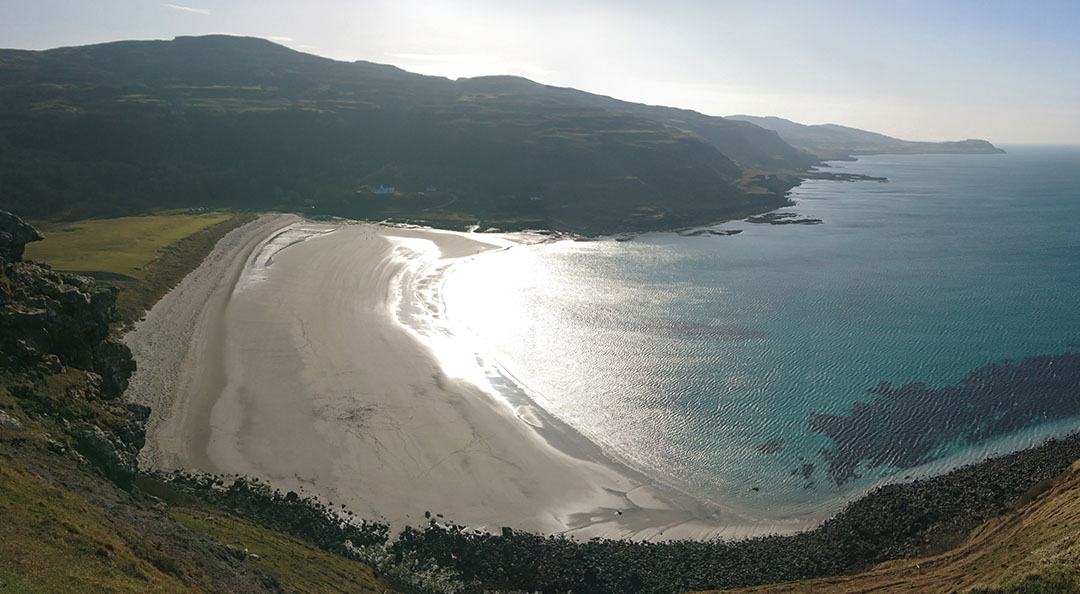
World Renowned Calgary Beach with it’s white sands and crystal clear waters.
5. Iconic Mull Landmarks & Must-Visit Attractions (Beyond Wildlife)
Beyond its living inhabitants, Mull boasts a wealth of historical sites and natural wonders.
- Duart Castle:
- A Highland Stronghold: Perched dramatically on a rocky outcrop guarding the Sound of Mull, Duart Castle is the ancestral home of the Clan Maclean.
- Experience: Explore its ancient walls, dungeons, and banqueting hall, and enjoy panoramic views of the sea and surrounding islands. For 2025, the castle is open from April 1st until October 18th. Opening hours vary by month, so it’s essential to check Duart Castle’s official website for specific daily opening hours and any closed days. A must-visit for history enthusiasts.
- Calgary Bay:
- Picture-Perfect Beach: Located in the north-west, Calgary Bay is famous for its stunning white sand beach and turquoise waters, often listed among Scotland’s best beaches.
- Activities: Ideal for a leisurely stroll, picnicking, or simply enjoying the breathtaking coastal scenery. There’s also an art in nature trail nearby.
- Ben More:
- Mull’s Munro: The island’s only Munro (a Scottish mountain over 3,000 feet), offering a challenging but incredibly rewarding hike with expansive views across the Inner Hebrides.
- Experience: Requires good fitness and navigation skills, but provides unparalleled vistas on a clear day.
- Tobermory Distillery:
- Island Whisky: Take a tour of this historic distillery, established in 1798, and sample its unique single malt whiskies. It is generally open daily from 11:00 – 17:00 in 2025 (check their official website for current tour availability and booking). A perfect activity for whisky aficionados.
- MacCulloch’s Fossil Tree:
- Geological Wonder: A preserved fossilised tree, standing within a basalt column near Burg, testament to Mull’s volcanic past. It requires a long, strenuous walk (approx. 5 miles/8.5km round trip, allow 6 hours) along a rough and sometimes steep path, including a steep descent via an iron ladder. Not suitable for dogs beyond a certain point due to the ladder. Offers spectacular coastal views en route.
- Carsaig Arches:
- Dramatic Coastal Formations: A stunning series of natural rock arches carved by the sea, located on the wild south coast. The walk to them is demanding (approx. 8 miles, 6 hours, hard grading) with rocky, narrow cliff paths and vertiginous drops. It should not be attempted in bad weather or by inexperienced walkers.
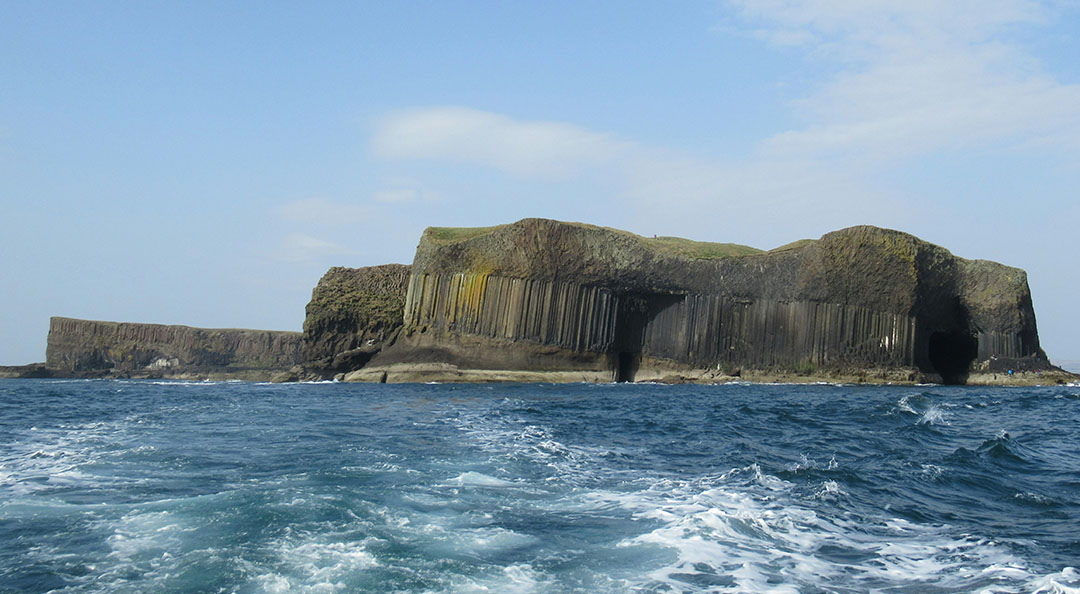
Isle of Staffa with it’s majestic basalt columns rising from the sea.
6. The Magic of Mull’s Neighbours: Day Trips to Iona & Staffa (Fingal’s Cave)
Mull serves as the perfect base for exploring two of Scotland’s most iconic smaller islands.
- Isle of Iona:
- Spiritual Heart: A small, tranquil island off Mull’s southwest coast, Iona is famed for being the cradle of Christianity in Scotland.
- Attractions: Visit the historic Iona Abbey (open generally 9:30am-5:30pm Mon-Sat and 12:30pm-5:30pm Sun from April to September; check Historic Environment Scotland’s website for current times and any short-notice closures due to ferry disruption), the Nunnery, and St. Oran’s Chapel. Walk to the beautiful white sandy beaches.
- Getting There: A short (approx. 10-minute) passenger-only ferry from Fionnphort on Mull. Cars are not permitted for visitors.
- Staffa (and Fingal’s Cave):
- Geological Marvel: An uninhabited island renowned for its unique basalt columns, forming the spectacular Fingal’s Cave. Its hexagonal pillars are similar to the Giant’s Causeway in Northern Ireland.
- Experience: Boat tours allow you to land and walk inside the cave (weather permitting), or view it from the sea. The acoustic properties of the cave are legendary. Note for 2025: Some boat operators, like Staffa Tours, have announced that due to essential maintenance work on Staffa by the National Trust for Scotland, landings may not be possible until at least mid-June 2025. Trips will still run, offering sea views of the cave. Always confirm landing status directly with your chosen tour operator before booking.
- Getting There: Various reputable boat trips depart from Fionnphort, Ulva Ferry, or Tobermory, often combining Staffa with a visit to the Treshnish Isles for puffin watching. Book in advance, especially during peak season.

Paddle Boarding in the crystal waters of Uisken Beach. (Bunessan)
7. Adventures & Activities: Hiking, Cycling & Outdoor Pursuits on Mull
Mull is an outdoor enthusiast’s paradise, offering diverse opportunities for exploration.
- Hiking & Walking:
- Coastal Paths: Discover stunning coastal walks, from gentle strolls along beaches to rugged clifftop trails.
- Forest Trails: Explore the island’s woodlands, like those around Ardura or Aros Park.
- Mountain Ascents: Beyond Ben More, there are numerous hills offering fantastic views for those seeking a challenge.
- Cycling:
- Scenic Routes: Mull offers some incredibly scenic cycling, though many routes involve challenging hills and single-track roads. The quiet roads make for peaceful riding, just be mindful of traffic.
- Kayaking & Canoeing:
- Sea Kayaking: Explore Mull’s intricate coastline, sea caves, and hidden coves from the water. Tours and rentals are available.
- Fishing:
- Sea and Freshwater: Opportunities for both sea angling and freshwater fishing in Mull’s lochs and rivers (permits may be required).

Lunch at Macgochan’s Tobermory, officially recommending the burgers!
8. Where to Stay & Eat: Accommodation & Dining on the Isle of Mull
Mull offers a range of options to suit every taste and budget, from cozy B&Bs to self-catering cottages and hotels.
Accommodation:
- Hotels: Found primarily in Tobermory, Craignure, and some smaller villages, offering traditional hospitality.
- Bed & Breakfasts (B&Bs): A popular choice, providing a personal touch and local insights, often found across the island.
- Self-Catering Cottages: Ideal for families or longer stays, offering flexibility and privacy, with options ranging from rustic to luxurious.
- Campsites & Glamping: For those seeking a closer connection with nature, several campsites and glamping pods are available.
- Location Choice: Consider basing yourself in Tobermory for a lively atmosphere, Craignure for ferry convenience, or Fionnphort for easy access to Iona. More remote areas offer profound tranquility.
Dining:
Mull’s culinary scene benefits greatly from its fresh local produce, especially seafood.
- Tobermory: Offers the widest selection of restaurants, cafes, and pubs, serving everything from fresh seafood to traditional Scottish fare.
- Seafood: Don’t miss the chance to try locally caught seafood, including scallops, mussels, crab, and freshly caught fish. Look for “Mull seafood” on menus.
- Local Produce: Many eateries pride themselves on using locally sourced ingredients, including island-reared lamb and venison.
- Pubs: Traditional pubs often serve hearty meals and provide a welcoming atmosphere to mingle with locals and fellow travelers.
- Cafes: Perfect for light lunches, coffee, and delicious homemade cakes.
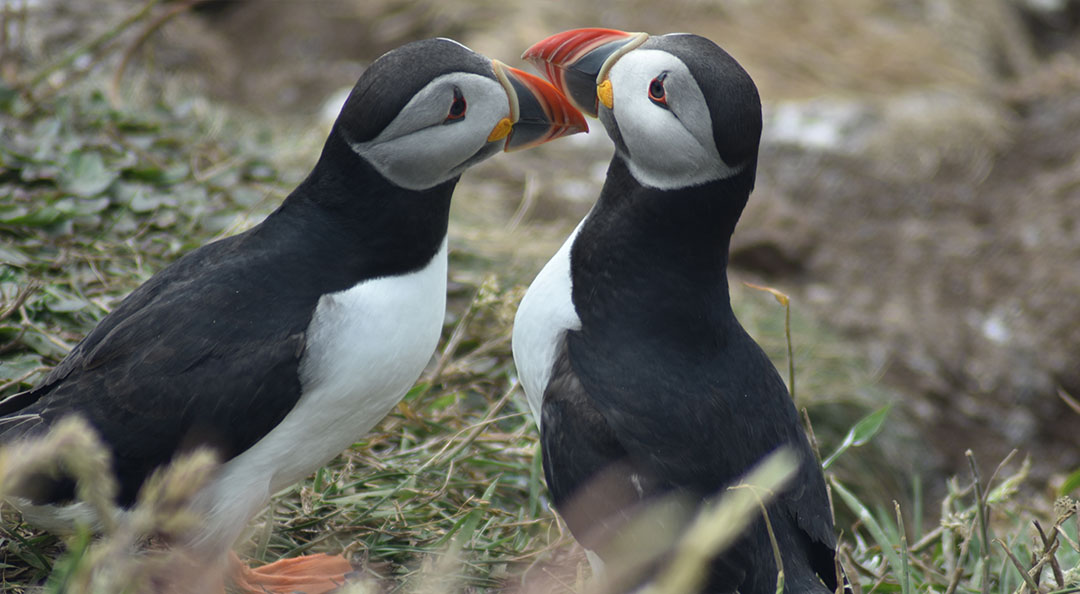
Don’t miss the puffins on Staffa!
9. Best Time to Visit Mull & Essential Tips for Your Trip
Timing and preparation can significantly enhance your Mull experience.
- Best Time to Visit:
- Spring (April-May): Often sunny, fewer midges, abundant wildlife (puffins start arriving), and beautiful wildflowers.
- Summer (June-August): Peak season, warmest weather, longest daylight hours, all attractions open, but busier and require advance bookings for everything (ferries, accommodation, tours).
- Autumn (September-October): Can be stunning with changing colours, still good for wildlife, fewer crowds, but weather becomes more unpredictable.
- Winter (November-March): Quietest period, some attractions may close, limited services, but offers a unique, wild, and dramatic beauty for those seeking solitude. Wildlife (especially eagles) can still be seen.
- Midges: The infamous Scottish midge is most active from late May to September, particularly in still, damp conditions, especially at dawn and dusk. Bring repellent (Avon Skin So Soft is a local favourite!) and consider a midge net.
- Weather: Scottish weather is famously changeable. Be prepared for all four seasons in one day! Pack layers, waterproofs, and sturdy footwear. Even in summer, temperatures can be cool.
- Cash: While card payments are widespread, having some cash is advisable, especially in smaller, more remote establishments.
- Mobile Signal: Mobile phone signal can be intermittent or non-existent in more remote areas of the island.
- Respect the Environment: Mull’s natural beauty is fragile. Stick to paths, take all your litter home, and leave no trace. Be mindful of sheep and deer on roads.
- Book Ahead: Especially for ferries, accommodation, and popular wildlife tours, booking well in advance is crucial, particularly during peak season.

Religious or not a trip to Iona is a must, get a guided tour of the Abbey.
10. Planning Your Perfect Mull Itinerary (Suggested Routes)
To help you visualise your trip, here are a couple of suggested itineraries that can be adapted to your interests and pace.
Option A: The Wildlife & Landmark Explorer (5-7 Days)
- Day 1: Arrival & Tobermory: Arrive at Craignure, drive to Tobermory. Settle in, explore the colourful harbour, and Tobermory Distillery. Evening meal in Tobermory.
- Day 2: North Mull & Coastal Beauty: Explore Calgary Bay, Dervaig (Kilmore Church), and search for wildlife along the north coast. Consider a visit to Duart Castle on your return south.
- Day 3: Marine Wildlife Adventure: Full-day boat trip from Tobermory or Ulva Ferry for whale watching and general marine wildlife spotting.
- Day 4: Iona & Staffa Excursion: Drive to Fionnphort. Take the ferry to Iona (visit the Abbey, explore the island) and a boat trip to Staffa (Fingal’s Cave and puffins if in season, noting potential landing restrictions for 2025).
- Day 5: South Mull Exploration: Drive the A849 south. Explore the Carsaig Arches (if fit for a strenuous hike) or the Lochbuie Stone Circle. Perhaps a shorter wildlife walk near Salen.
- Day 6 (Optional): Ben More or Hidden Gems: For the adventurous, hike Ben More. Alternatively, explore a less-visited area, or revisit a favourite spot.
- Day 7: Departure: Enjoy a final Mull breakfast before heading back to Craignure for your ferry to Oban.
Option B: The Laid-Back Nature Lover (3-4 Days)
- Day 1: Arrival & Craignure/Salen Base: Arrive at Craignure, check into your accommodation in central Mull. Explore Duart Castle nearby.
- Day 2: Tobermory & North Mull Gentle Exploration: Drive to Tobermory. Enjoy the town, then perhaps a gentle walk at Calgary Bay.
- Day 3: Iona & Coastal Charm: Drive to Fionnphort for a day trip to Iona. Enjoy the serene beauty of the island and the Abbey.
- Day 4: Wildlife Spotting & Departure: Take a morning wildlife tour, or spend time quietly searching for otters along a coastline. Depart from Craignure.
The Isle of Mull promises an immersive escape into some of Scotland’s most breathtaking natural beauty and rich cultural heritage. By planning ahead and embracing its unique island character, you’re set for an unforgettable adventure. Enjoy your journey to this magnificent corner of the world!

